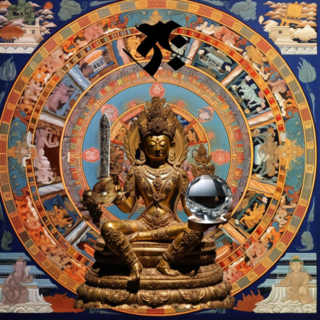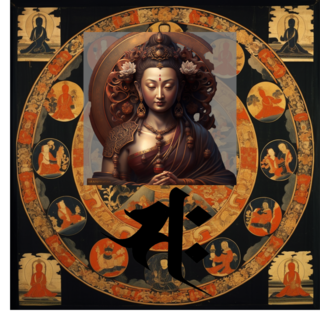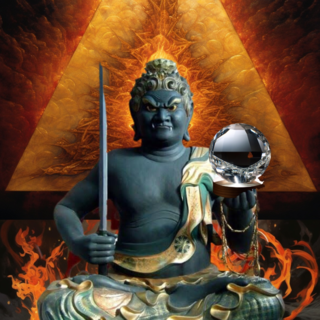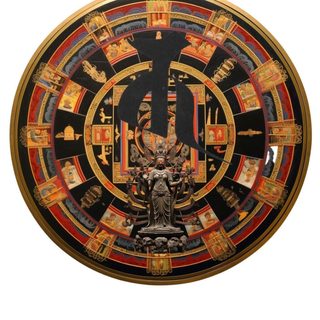�@���̓��͕̂��@ �u�@����炷�ׂ��v�@�@The essence of the Tathagata is Buddhism: �gYou should worship the Tathagata.�h
-�@���̓��͕̂��@
�u�@����炷�ׂ��v
- �@���̓��͕̂��@�ł���A�u�@����炷�ׂ��v�͕��Ƃ��̖@���q����ׂ��Ƃ����Ӗ��B
- �@���̓��͕̂��@�����S�ɑ̓����Ă��邽�߁A�@�����q���邱�Ƃ͕��@��ʂ��Đ^���𗝉����邱�ƁB
- ���@��m��Ȃ��҂͖}�v�ł���A�C�s���ĕ��@��̓����悤�Ƃ���҂��C�s�ҁB
- �@�����q���邱�Ƃ͕��ɂ��̂��̂����łȂ��A���@��ʂ��ĕ��ɂ��q���邱�ƁB
- ���@�͐^���ł���A���ɂ͐^���̑̌��ҁB��q��ʂ��Ēq�d�Ɖ�E��������Ƃ��߉ނ��܂͋�����B
- �u�~���ґz�v��ʂ��Ĕ@���ƕ��@���q���A��̂ƂȂ邱�ƂŒq�d�Ɖ�E��������B
- ���@�̋Ɉӂ͕��̒q�d��̓����A������f����ł����邱�ƁB�����͗�q���ґz�ɂ���ē�����B
- �w�L���i�E���x�ł́u�@���炷�ׂ��v������A�u�@��v�Ƃ͕��̋��������łȂ��A�����@���w���Ɖ��߁B
- ��C�́w�ٌ����_�x�ɂ����āA�O�\����@���@��ł���Ɛ�����Ă���A���ꂪ��q�ΏہB
- ���߉ނ��܂̋����ł́A�u�@���炷�ׂ��v�͎�����A�C�s�����H���邱�Ƃ��Ӗ�����B
- �u�_�_�v���K�╧�����w���A���ɂ̖{�̂���@���q�����B����_�_�Ƃ��Ĉ��@�M�k�ɂƂ��ďd�v�B
- �u�_�v�͕����܂̐S���w���A�_�_�͕����܂̖{���̂��S���J������B��⓹�ꂪ�_�_�Ƃ����B
- ���߉ނ��܂́u�_�_��点��v�Ƌ����A���@�ɓ��B���邽�߂̓�̕��@������B����͐_�_��ʂ��ĕ��@�ɓ��B����B
- �u�L���i�v�͌㐢�̂��߂ɐ����ꂽ���o�ł���A�@��Ɛ_�_���q���邱�Ƃŗ͂Ɩ���Ɛ�����Ă���B
The essence of the Tathagata is Buddhism, and ``You should worship the Tathagata'' means that you should worship the Buddha and his Dharma.
- The entity of the Tathagata has completely mastered the Buddha Dharma, so worshiping the Tathagata means understanding the truth through the Buddha Dharma.
- Those who do not know Buddhism are ordinary people, and those who practice and try to master Buddhism are practitioners.
- Worshiping the Tathagata means not only worshiping the Buddha himself, but also worshiping the Buddha through the Dharma.
- Buddhism is truth, and Buddha is the embodiment of truth. Buddha teaches that wisdom and liberation can be gained through worship.
- By worshiping the Tathagata and Buddhism through ``stop meditation'' and becoming one with them, you can gain wisdom and liberation.
- The secret of Buddhism is to master the wisdom of the Buddha and sever all ties and destroy them. These can be obtained through worship and meditation.
- In the ``Usuhin-Hachi'', there is a phrase, ``You should worship the Dharma Treasure,'' and ``Dharma Treasure'' is interpreted to refer not only to the Buddha's teachings, but also to the Dharma of attaining Buddhahood.
- In Kukai's ``Benken Esoteric Buddhism'', he explains that the 37 Bodhi Dharma is the Dharma Treasure, and this is the object of worship.
- In the Buddha's teachings, ``One should bow to the Dharma treasure'' means to take it in and put it into practice.
- "Shinmyo" refers to a shrine or pagoda, and is a place to worship the Buddha's body and the Dharma of Buddhahood. The Gohoto is important to Agon sect believers as a shrine.
- "Kami" refers to the heart of Buddha, and a shrine is a place where the true heart of Buddha is enshrined. The treasure pagoda and dojo are considered sacred shrines.
- Buddha teaches, ``Be respectful to the shrine,'' and explains two ways to attain Buddhism. In modern times, we reach Buddhism through shrines.
- ``Musuhin'' is a sutra preached for posterity, and it is said that one can gain power and fearlessness by worshiping Dharma treasures and shrines.
�Ƃ́A���Ƃ��̖@��炷�ׂ��Ƃ����Ӗ��ɂȂ�܂��B �Ȃ��Ȃ�A �@���̓��͕̂��@������� ���B���@�����S�ɑ̓����Ă��邩��@���Ȃ̂ł��B ���@���܂������m��Ȃ���Ζ}�v�ł��B ���@ ��̓����悤�ƏC�s���Ă���҂��C�s�҂ł��B �v����ɔ@�����q����Ƃ́A���ɂ�����z���� �����Ӗ��ł͂Ȃ��āA���ɂ̂��Ȃ��ɕ��@������ƌ���A�Ƃ������Ƃł��B ���ɂ��q����Ƃ� �����Ƃ́A���ɂ��̂��̂����ł͂Ȃ��āA���ɂ�ʂ��ĕ��@���q����Ƃ������Ƃɂق��Ȃ�� ����B ���@�Ƃ́A������₷�������ΐ^���ł��B ���ɂƂ͐^���̑̌��҂ł��B �v����ɁA�^���̑̌��҂�ʂ��Đ^��������A�Ƃ������Ƃł��B���̂��߂Ɂu�~���ґz�v�����āA�Ђ�����@���� ���̕��@���q���Ĉ�̂ƂȂ�A�Ƃ��߉ނ��܂͋����Ă�����킯�ł��B
����ɂ���ē�̖@��������̂ł��B
�u��ɒq�d�Ƃ��A��ɖŐs�ƈׂ��v
�Ƃ���悤�ɁA�q�d�ƖŐs�������܂��B
�q�d�Ƃ͕��̒q�d�A�݂₭�������B�s�Ƃ͉���̂��Ƃł��B�J���}�������ł����邱�ƁA���ꂪ��E�ł��B
���@�̋Ɉӂ͓����܂��B��͕��̒q�d��̓����邱�ƂŁA������͈�����f����A ������ł����邱�Ƃł��B�J���}���璴�z���邱�Ƃł��B�����͔@�����q�����ґz���邱 �Ƃɂ���ē����܂��B �@����ʂ��āA�@���̖@�邱�Ƃɂ��A�q�d�Ɖ�E��������̂��A ���߉ނ��܂͂���������Ă���킯�ł��B
���́w�L���i�E���x�ł́A
�u���̓�@�L��A���Ɏ���v�҂��A�ꐸ�ӂ���ɂ��ē��ɖ@���炷�ׂ��B �@���̐_�_��点 ��v�Ƃ���܂��B �u���Ɏ���v�҂��A�ꐸ�ӂ���ɂ��āv�Ƃ́A�O�o�Ɠ������u�~���ґz�v������ �Ă��܂��B �u�@���炷�ׂ��v�̖@��Ƃ́u�@�Ƃ�����v�̂��Ƃł��B �O�o�ł́u���ɔ@���� �u��q���Ȃ����v �ƂȂ��Ă���܂����B�����āw�L���i�E���x�ł́A�u�@����q���Ȃ����v �Ƃ� ���Ă��܂��B
�킽���������̕��������߂Ėڂɂ������A�����ɓ��ɕ����͍̂O�@��t��C�́w�ٌ��� �_�v�ł��B��C�́w�ٌ����_�x�A�����āw�_�x�Ƃ����L���ȏ����L���Ă����� ���B����͕����������Ɩ����̓�ɕ��ނ��A�����̗D�ʂ����������ŁA�^�������̍��{���` ��m���Ŕ��ɏd�v�Ș_���Ƃ���Ă���܂��B ��C�͓��_�����ŁA
�u���@�����d�ʎ��E�@�g�B���@�������q�d���������B�����O�\����@�B�T���� �C���@���\�ؔސ���@�g(���̖@��Ƃ͑���������Ȃ�B���̖@��Ƃ�
�̏��̖������Ȃ�B������O�\�����Ȃ�B�T���A���̖@���C������ȂĖʂ����\���ނ̐��� �@�g����)�v
�ƋL���Ă����܂��B �O�\����@�Ƃ́A�킽���������߉ނ��܂̐����@���Ƃ����Ă���A ���ȎO�\�����i�̕ʖ��ł��B���ꂪ�@��ł���Ƌ�C�͂���������Ă���̂ł��B
�킽�������w�L���i�v�́u�@���炷�ׂ��v�Ƃ����ӏ���ǂ�ŁA�ŏ��Ɏv���������̂͑O�q �̕��͂ł����B�������w�_�x�̂��̕��͂����ŁA��C���u���܌o�v��ǂ�ł����Ƒ��f�� �邱�Ƃ͑��v��������܂��A���Ȃ��Ƃ��O�\����@�̖��O�͂����m�ł���A�܂����ꂪ �@��ł���Ƃ���������Ă��邱�Ƃ́A�܂�����Ȃ������ł��B����Ȃ̂ɂǂ����Đ^���@�� �ĂāA�u���܌o�v�Ƃ��̐����@�𗧂ĂȂ������̂�? ���̓_�͋^��ł���A�܂��A���̂킽 ���������ɂ͒m��R������܂��A��C���O�\����@�̑��݂������m�ł��������Ƃ́A�� ������M���m���Ƃ����킯�ł��B
���o�ɖ߂�܂��B ���߉ނ��܂́u�@���炷�ׂ��v�Ƃ���������Ă���܂����A�܂��ɋ�C�� �w�_�x�ɂ���悤�ɁA���̖@��Ƃ͒P�ɕ��̋������w���̂ł͂Ȃ��A���߉ނ��܂̐����@�E �ȎO�\�����i�������Ă���A�Ƃ킽�����͉��߂��Ă���܂��B���߉ނ��܂̐����@��@�̕�� ���ė�q���Ȃ����A�Ƃ����Ӗ��ɈႢ�Ȃ��B��q���Ȃ����Ƃ����Ă��A�P�ɗ�q����Ƃ������� �ł͂Ȃ��A ����́A
�u������Ȃ����B�C�s���Ȃ����v
�Ɖ��߂��ׂ��ł��傤�B
�Ƃ���܂��B �_�_�Ƃ��K�ł��B�����ł����_�_�Ƃ͕��� (���ɗ���) �ł���܂��B�܂�@�� �̖{�̂��J�����������q����A�Ƃ����Ӗ��ł��B
���@�̐M�k�͕��ɗ���쑸���(�ȉ��A���)��{���Ƃ��āA�u���ɗ���쑸��E�� �u�s�v�Ƃ���������E�s���C�s���Ă���܂����A���̌�������w�L���i�E���x�̐_�_�ɂ����� ���̂ł��B ��͌�@���Ƃ������܂����A���ꂪ�݂Ȃ���̐_�_�ł��B �܂��A������J���� ���邲�{�����܂��_�_�ł��B
�_�_�́u�_�v�Ƃ́A�����܂̐S�̂��Ƃł��B�_���܂ł͂Ȃ��A���_�E�_���́u�_�v�ł��B ���� �܂̖{���̂��S�����J�肵���K�A���ꂪ�_�_�ł��B�܂��ɁA���@�ŏ�����w���ɗ���쑸�a �]�x�ɁA
�u�ω��@�g���ɗ��� �[���J�����K�Ȃ�v
�Ƃ���Ƃ���ł�(�u�A���f�B���̖��@�̃����v���ɗ���쑸�a�]�x ���@�o�ŕ�)�B�킽������ ���ɂƂ��Ĕ@���̐_�_�Ƃ́A��ɂق��Ȃ�܂���B
�u���Ȃ������͔@���̐����@�E���ȎO�\�����i���h���A��q���A �����Ă��̏C�s�����s���Ȃ����B �����āA���S�����q���Ȃ����v
���߉ނ��܂͂��������������Ă���킯�ł��B
�ŏ��̂��o�ƕ����čl���Ă݂�ƁA�悭�������Ă��܂��B �܂�A���ɂ������Ȃ����͕��� ��z���A�����ĕ��ɂ̂��Ȃ��ɂ��镧�@��z���킯�ł��B����ɍӂ��Ă����A�u���ɂ�z���v �Ƃ́A���ǁA�u�_�_��点��v�Ƃ������ƂɂȂ�܂��B�Ⴂ�́A�_�_��ʂ��ĕ��@�ɓ��B���悤 �Ƃ��邩�A���邢�͕��ɂ��̂��̂�ʂ��ĕ��@�ɓ��B���悤�Ƃ��邩�A�Ƃ����_�ł��B
���߉ނ��܂͂����ŁA���@�ɓ��B�����̕��@������Ă���������킯�ł��B ���ɂ����� ���łȂ�����́A���R�̂��ƂȂ���A�_�_��ʂ��ĕ��@�ւ̓��B���߂������ƂɂȂ�܂��B���� �悤�ȈӖ��ŁA�w�L���i�x�͌㐢�̂킽���������̂��߂ɐ����ꂽ���o���Ƃ킽�����͍l���܂��B
���̎l���E��F�̎l����
����ł́A�@��Ɛ_�_���q����ƁA�Ȃɂ�������̂ł��傤��?
�u������@�Ȃ��B �͗L��A���ؗL��v
�Ƃ���悤�ɁA��̖@�邱�Ƃ��ł��܂��B��͗͂ŁA������͖����ł��B �͂Ƃ͂� ��ł��傤��?
�������邾���̗͂ł��B �����͂ł��B
���Ƃ͂Ȃɂ�?
�����Ȃ��S�ł��B ���̒��ɂ����āA��Ȃ��S�قNj������̂͂���܂���B ��������
-The essence of the Tathagata is Buddhism
�gYou should worship the Tathagata.�h
This means that one should respect the Buddha and his dharma. This is because the essence of the Tathagata is Buddhism. He is a Tathagata because he has completely mastered Buddhism. If you don't know Buddhism at all, you're an ordinary person. A person who practices in order to master Buddhism is a practitioner. In short, worshiping the Tathagata does not mean that you should think only of the Buddha, but that you should see beyond the Buddha that there is Buddhism. When he says that he worships the Buddha, he is not only worshiping the Buddha himself, but he is worshiping the Buddha Dharma through the Buddha. To put it simply, Buddhism is truth. Buddha is the embodiment of truth. In short, see the truth through the person who embodies it. For this purpose, the Buddha taught us to practice ``stop meditation,'' and to worship and become one with the Tathagata and his Buddhism.
As a result, two laws can be obtained.
�gFirst, wisdom, second, extinction.�h
As the saying goes, you can gain wisdom and extinction.
Wisdom is the wisdom of Buddha, Miyakusandai. Extended means explanation. Eliminating karma and fate is liberation.
There are two secrets of Buddhism. One is to acquire the wisdom of the Buddha, and the other is to sever ties and destroy them. It is about transcending karma. They are obtained by worshiping and meditating on the Tathagata. The Buddha is saying that by acquiring the Tathagata's Dharma through the Tathagata, one can gain wisdom and liberation.
In the next ``Nothing or No Items Eight,''
It says, ``There are these two dharmas, so think within yourself, devote all your concentration, and bow down to the Dharma Treasure. Bow to the shrine of the Tathagata.'' ``Thinking inwardly and with one mind'' refers to ``stop meditation,'' as in the previous sutra. The Dharma treasure in ``You should bow to the Dharma treasure'' refers to the ``treasure called law.'' In the previous sutra, it said, ``Worship the Buddha Tathagata.'' And in ``Jumonin 8,'' he says, ``Worship the Dharma Treasure.''
When I first saw this section, what immediately came to mind was Kobo Daishi Kukai's ``Benkenmitsu Nikkyoron.'' Kukai wrote a famous book called ``Benken Esoteric Nikkyo Ron'', or ``Nikyoron'' for short. This is a work that divides Buddhism into two, Exoteric Buddhism and Esoteric Buddhism, and explains the superiority of Esoteric Buddhism, and is considered an extremely important treatise for understanding the fundamental doctrines of Shingon Esoteric Buddhism. Kukai, in the second volume of the same theory,
``The first Dharma Treasure is the Dharmakaya, the Buddha of liberation. It is understandable. What is the second Dharma Treasure?
There are many wonderful merits. The so-called thirty-seven. By practicing this Dharma, one can prove one's purity and Dharma body.
He wrote: The Thirty-Seven Bodhisattva Dharma is another name for the Thirty-Seven Paths of the Seven Sciences, which I say is the Buddha's method of attaining Buddhahood. Kukai said that this is the Dharma Treasure.
The first thing that came to my mind when I read the passage ``You should bow down to the Dharma Treasures'' in ``Jibunin'' was the passage mentioned above. Of course, it may be premature for him to immediately conclude that Kukai read the Agon Sutra based on that passage in "Nikyo Ron," but he at least knows the name of the 37 Bodhi Divination Methods. , and that you say that it is a Dharma treasure is an unmistakable fact. So why did he not establish the Shingon sect and establish the Agon Sutra and its method for attaining Buddhahood? This is a questionable point, and although there is no way for us later generations to know, Kukai taught the Thirty-Seven Bodhisattvas. It can be seen from the literature that he was aware of the existence of the division method.
He returns to the sutra. Buddha said, ``One should worship the Dharma Treasure,'' but just as in Kukai's Theory of the Two Teachings, this Dharma Treasure does not simply refer to the Buddha's teachings, but to Buddha's Dharma for attaining Buddhahood. My interpretation is that it indicates the 17 Ways of Honor. It must mean that you should worship Buddha's Dharma of Buddhahood as the treasure of the Dharma. When I say worship, I don't just mean worship;
"Take it in. Practice it."
It should be interpreted as
It says. A shrine is a shrine. In Buddhism, a shrine is a stupa (stupa). In other words, it means to worship the stupa that enshrines the body of the Tathagata.
Believers of the Agon sect use the Buddha's Shari Hojuson Gohoto (hereinafter referred to as Gohoto) as their principal image, and practice the practice of releasing oneself from one's karma called ``Buddha Shari Hojuson Gohosho ``Gyo'', but this Gohoto is the ``Musuhin Hachi''. �h is his shrine. Gohoto is also written as Gohoto, but this is your shrine. In addition, the principal image of him that is enshrined in the dojo is a shrine.
The ``kami'' in the shrine is the heart of the Buddha. It is not a god, but a "god" of spirit and essence. This is a shrine that enshrines the true heart of Buddha. This is exactly what is said in ``Buddha Shari Hoju Sonwa San'' chanted by the Agon sect.
�gA spiritual shrine where the changing Dharma body and Buddha�fs relics can be enshrined.�h
As it is written (``Aladdin's Magic Lamp Buddha Shari Jewel Sonwasan'', Agonshu Publishing Department).For me, after him, the shrine of the Tathagata is nothing but a treasure pagoda.
"You should respect and worship the Tathagata's method of attaining Buddhahood, the Seven Courses, and the Thirty-Seven Paths, and carry out the training. Then, worship the Treasure Pagoda with all your heart."
Buddha is teaching us this.
If you think about it in conjunction with the first sutra, you will understand it better. In other words, when the Buddha is not there, we think of the Buddha, and then we think of the Dharma that lies beyond the Buddha. To break it down further, ``remember the Buddha'' ultimately means ``respect the shrine.'' The difference is whether he tries to reach the Buddha Dharma through the shrine, or whether he tries to reach the Buddha Dharma through the Buddha himself.
Here, the Buddha is teaching us two ways to attain Buddhism. In modern times when the Buddha is no longer alive, it is natural that we aim to reach Buddhism through shrines. In his sense, I believe that ``Juubin'' is a sutra that was preached for us in future generations.
The four fearlessness of the Buddha and the four fearlessness of the Bodhisattva
So, what do we gain by worshiping Dharma treasures and shrines?
"What are the two laws? There is power and there is no fear."
As the saying goes, you can obtain two methods. One is power and the other is lengthless. What is power?
It is the power to attain Buddhahood. It is the power to attain Buddhahood.
What is fearlessness?
It is a heart that is not afraid of anything. There is nothing stronger in this world than a fearless heart. Because it's strong
http://cyber-price.com/buddha/Buddha�@ Japan�@JournalBuddha Japan journal
���{�̕����M���܂�Send Japanese Buddhis
Buddha 2
Japan journal���{�̕����M���܂�Send Japanese Buddhis s�T�C�g
����@���̒q�d��\�������u�����E�v .���� "Kongokai" expressing the wisdom of Dainichi Nyorai.Ichiinkai �ّ��E��䶗��@������������ Womb Realm Mandala Taizokai



















![�O��]�������̃o�����X���]���œK������](https://waters-takeshiba.jp/cmsdata/news/assets_c/2020/03/aak875b3n8ch-thumb-600x619-78.png)